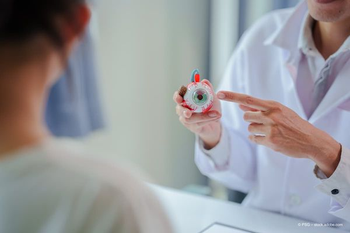
PEACHTREE post hoc analysis: Significant reduction of macular edema, low rate of rescue in patients with chronic uveitis
Christopher Henry, MD, presented a talk entitled, “Efficacy of Suprachoroidal Triamcinolone Acetonide Injectable Suspension in the Treatment of Macular Edema in Patients With Chronic Uveitis,” at ASRS 2022 in New York City, New York.
Video transcript
Emily Kaiser [EK]: Hello and welcome to our 2022 ASRS coverage. Today I'm speaking with Dr. Christopher Henry about the efficacy of suprachoroidal drug delivery via injection for the treatment of macular edema in patients with chronic uveitis. First, can you give us a brief summary of PEACHTREE?
Christopher Henry, MD [CH]: Yeah, so basically, PEACHTREE was a Phase 3, randomized, controlled, double masked, multicenter trial. And this looked at suprachoroidal steroids compared to sham injections. So, patients in the treatment arm got a suprachoroidal steroid injection at day 0 and week 12, and patients in the control arm received a sham injection at day 0 and week 12. And then there are 96 patients in the treatment arm and 64 patients in the control arm.
And overall PEACHTREE met its primary endpoint with 47% of patients in the treatment arm gaining 15 or more letters, compared to 16% in the control arm. And based on the results of this trial, Xipere has now been FDA approved for the treatment of macular edema associated with uveitis.
EK: Thank you for that. And can you tell us a little bit more about your study?
CH: So our study looked at PEACHTREE and basically we did a post hoc analysis, specifically looking at patients with chronic uveitis.
So we define chronic uveitis as according to SUN criteria, and that's patients having persistent uveitis with a relapse less than 3 months after having discontinued prior treatment. And so, in our study, there were 60 patients in the treatment arm who had chronic uveitis and 41 patients in the control arm who had chronic uveitis. And again, this is a post hoc analysis of PEACHTREE, which we just summarized.
So patients in the treatment arm gained a mean of 12.1 letters by week 24, compared to just 4.2 letters amongst those in the control arm. And so this was a statistically significant difference in visual acuity improvements over the course of the 24 [weeks].
And similarly, we looked at improvements in macular edema in patients in the treatment arm—compared to patients in the control arm—amongst these patients with chronic uveitis, and what we found is that patients in the treatment arm can improve by a mean of 154 micron reduction in macular edema at week 24, compared to just 34 microns amongst those in the control arm. And again, this was a statistically significant difference between the two groups.
A final thing we looked at was time to rescue. Over the 24-week period of the study, there were about 66% of patients in the control arm who needed to be rescued. And this was typically with local steroid therapy. This compared to just 17% amongst those in the treatment arm. And we did a Kaplan-Meier analysis, which showed this was a statistically significant difference in the need to be rescued and time to rescue.
And if we looked at the median time to rescue in the control arm, this was 139 days; but, we were not able to estimate this in the treatment arm just because such a small percentage of patients were needed to be rescued.
Overall summary of our study is that when we specifically looked at the subset of patients with chronic uveitis from PEACHTREE, we found a clinically meaningful, functional, and anatomic benefit for the treatment arm as compared to the control arm.
EK: Fantastic. Well, thank you so much for filling us in on your study. This is really great. Thank you.
CH: You're welcome. Happy to share.
Note: This transcript has been lightly edited for clarity.
Newsletter
Keep your retina practice on the forefront—subscribe for expert analysis and emerging trends in retinal disease management.










































